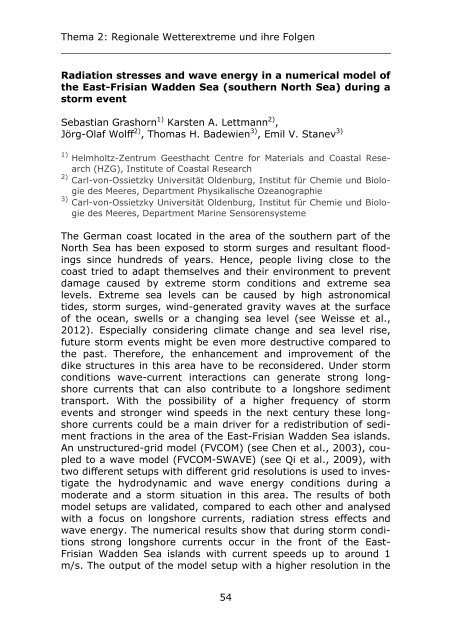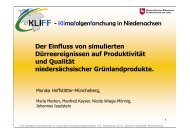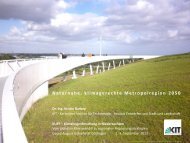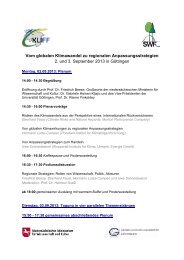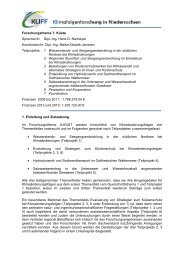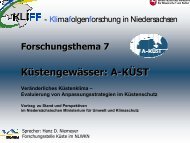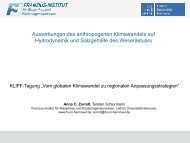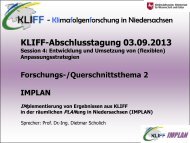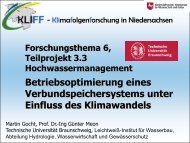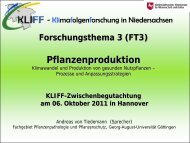Abstract-Band KLIFF-Tagung 2.und 3.9.13
Abstract-Band KLIFF-Tagung 2.und 3.9.13
Abstract-Band KLIFF-Tagung 2.und 3.9.13
Sie wollen auch ein ePaper? Erhöhen Sie die Reichweite Ihrer Titel.
YUMPU macht aus Druck-PDFs automatisch weboptimierte ePaper, die Google liebt.
Thema 2: Regionale Wetterextreme und ihre FolgenRadiation stresses and wave energy in a numerical model ofthe East-Frisian Wadden Sea (southern North Sea) during astorm eventSebastian Grashorn 1) Karsten A. Lettmann 2) ,Jörg-Olaf Wolff 2) , Thomas H. Badewien 3) , Emil V. Stanev 3)1)Helmholtz-Zentrum Geesthacht Centre for Materials and Coastal Research(HZG), Institute of Coastal Research2)Carl-von-Ossietzky Universität Oldenburg, Institut für Chemie und Biologiedes Meeres, Department Physikalische Ozeanographie3)Carl-von-Ossietzky Universität Oldenburg, Institut für Chemie und Biologiedes Meeres, Department Marine SensorensystemeThe German coast located in the area of the southern part of theNorth Sea has been exposed to storm surges and resultant floodingssince hundreds of years. Hence, people living close to thecoast tried to adapt themselves and their environment to preventdamage caused by extreme storm conditions and extreme sealevels. Extreme sea levels can be caused by high astronomicaltides, storm surges, wind-generated gravity waves at the surfaceof the ocean, swells or a changing sea level (see Weisse et al.,2012). Especially considering climate change and sea level rise,future storm events might be even more destructive compared tothe past. Therefore, the enhancement and improvement of thedike structures in this area have to be reconsidered. Under stormconditions wave-current interactions can generate strong longshorecurrents that can also contribute to a longshore sedimenttransport. With the possibility of a higher frequency of stormevents and stronger wind speeds in the next century these longshorecurrents could be a main driver for a redistribution of sedimentfractions in the area of the East-Frisian Wadden Sea islands.An unstructured-grid model (FVCOM) (see Chen et al., 2003), coupledto a wave model (FVCOM-SWAVE) (see Qi et al., 2009), withtwo different setups with different grid resolutions is used to investigatethe hydrodynamic and wave energy conditions during amoderate and a storm situation in this area. The results of bothmodel setups are validated, compared to each other and analysedwith a focus on longshore currents, radiation stress effects andwave energy. The numerical results show that during storm conditionsstrong longshore currents occur in the front of the East-Frisian Wadden Sea islands with current speeds up to around 1m/s. The output of the model setup with a higher resolution in the54


